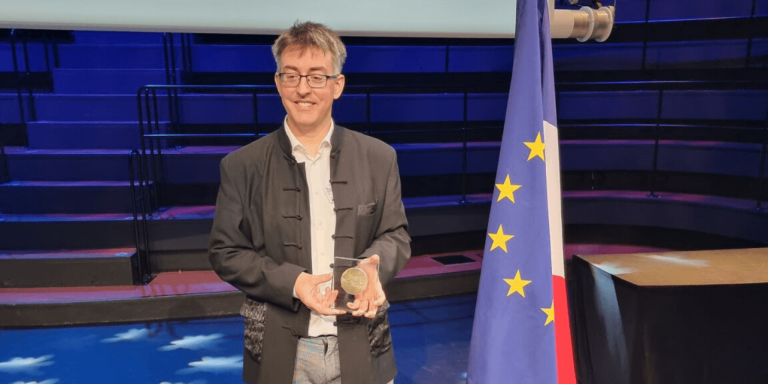
Created in 2013, the Stars of Europe awards recognize the coordinators of European collaborative research projects. On December 6, Sylvie Retailleau, Minister of Higher Education and Research, presented trophies to twelve winners at a ceremony at the Quai Branly Museum. Among them, Nicolas Mansard, CNRS researcher in robotics at LAAS-CNRS, holder of the ANITI chair ” Artificial and natural movement”, rewarded for the coordination of the MEMMO (memory of motion) project.
Funded by the Horizon 2020 program over a four-year period, MEMMO (Memory of Motion) is a collaborative project initiated in 2018 that brought together a consortium of 10 European partners for a budget of €4 million: LAAS-CNRS (France), IDIAP (Switzerland), University of Edinburgh (UK), Max Planck Institute (Germany), Oxford University (UK), Trento University (IT), PAL-Robotics (Spain), Wandercraft (France), Airbus (France), Costain (UK) and APAJH (France).
Nicolas Mansard, robotics researcher in the Gepetto team of LAAS-CNRS (Mouvement des Systèmes Anthropomorphes), CNRS Bronze Medalist, project coordinator said at the ceremony:
“I would like to thank the people who helped me coordinate this project. It is a project put together by a consortium of young researchers. It was a great pride for me to be chosen to coordinate this project.
He then added:
“We wanted to prove that it was possible to generate complex motions for arbitrary robots with arms and legs interacting in a dynamic environment in real time.
Storing optimal motions in memory
The computation of robot movements is complex and even more so for robots with arms and legs, moving in an unstructured environment.
For this project, the consortium has brought together a group of experts in numerical optimization, machine learning, control and robot design.
Nicolas Mansard explains:
“For a walking robot to react to a situation in real time, it has to solve a numerical problem with 10,000 variables in a millisecond, which is far beyond the scope of what artificial intelligence is capable of doing today. We invented Memory of Motion to meet this great challenge.”
The project team generated a massive amount of pre-computed optimal motion offline and compressed it into a database of possible reactions called Memory of Motion.
Nicolas Mansard comments:
“We use the best motion planners available to reduce [database] exploration time and improve the quality of the data generated, and we use machine learning to encode it into a memory of motion, which takes less storage. Then we optimally adapt a candidate motion from the memory to similar situations that have not been explicitly explored. This is called “generalization.”
When it moves, the robot recognizes a new situation thanks to its sensors in real time. It then selects an appropriate reaction from its memory and optimizes it using its predictive capabilities.
Nicolas Mansard adds:
“Online, we use this motion memory to guide an “optimization solver” that makes the final decision about how the robot should behave to maintain its balance, walk, manipulate tools and other things.”.
Three demonstrators validated by proof of concept
The team has developed three demonstrators:
- A humanoid robot to perform tooling tasks for aircraft assembly at a factory of the future with consortium partner Airbus in Toulouse;
- A walking exoskeleton has been paired with a paraplegic patient in a rehabilitation center under medical supervision, in partnership with the APAJH federation, an association for disabled adults and youth. A medical center is going to experiment with it.
- A quadruped robot capable of walking in a tunnel being dug or in buildings to be demolished, in partnership with Costain, the British constructor of the Channel Tunnel. It has also been tested with an existing commercial industrial inspection robot from Swiss company ANYbotics.
The same motion generator has been used to realize three very different demonstrators thanks to numerical optimization and machine learning, proof of concept has been achieved for all three, which allows to consider future applications.
Currently, the humanoid robot only exists in the laboratory, the quadruped works but is not commercialized, and the exoskeleton is already a tool used in rehabilitation centers.
Nicolas Mansard states:
“Today the exoskeleton allows patients to work on their rehabilitation in hospitals, but eventually it could replace the wheelchair.”
Translated from Robotique : Nicolas Mansard, coordinateur du projet MEMMO, lauréat des Etoiles de l’Europe









